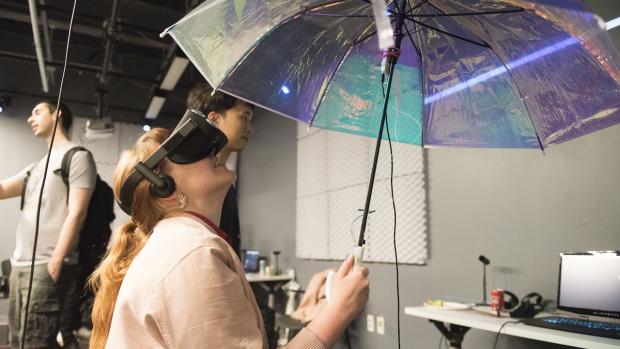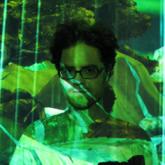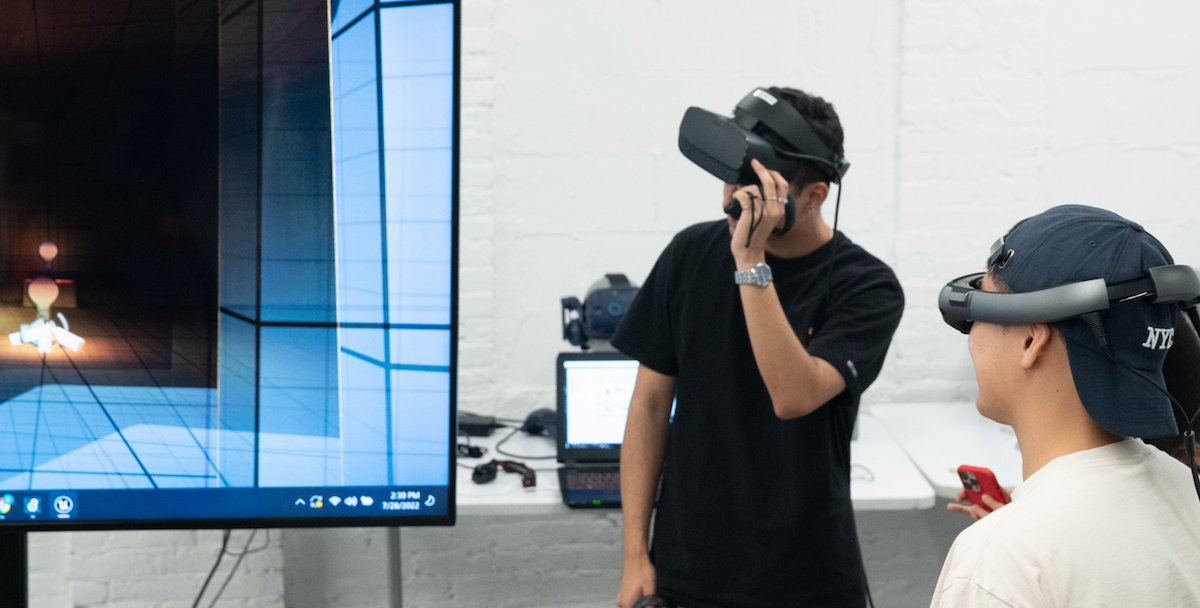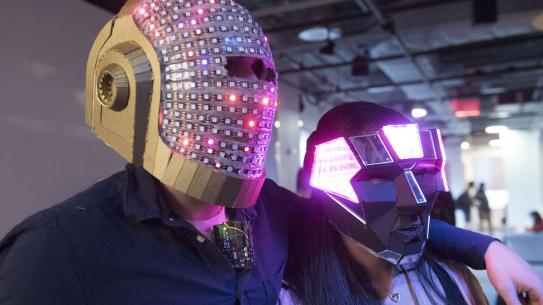For the second year in a row, NYU Tandon’s Integrated Design & Media program is ranked tops

Animation Career Review began publishing college rankings more than a decade ago, but it wasn’t until 2021 that its editors began looking specifically at courses of study involving augmented and virtual reality. That year, NYU Tandon’s Integrated Design & Media (IDM) program landed squarely in the top five, and this year the school made a sophomore appearance, coming in at number four on the publication’s list of the best private colleges for AR/VR in the nation.
The rankings took into account academic reputation and selectivity, among other factors, but here are four other major reasons for that impressive number-four showing:
A historical leg up
In early 2016, the first Oculus Rift headset hit store shelves, but Tandon had been offering relevant classes well before then and had opened what was to become the second largest motion capture studio in the city.
2004: The IDM program is founded at Polytechnic University as the Integrated Digital Media Institute (IDMI), with a class of 11 M.S. students.
2008: The IDM program expands to include a Bachelor of Science degree, admitting its first undergraduate students.
NYU-Poly and NYU receive a grant from Microsoft Research to launch the Games for Learning Institute (G4LI), a game-based scientific research alliance.
2010: In partnership with Columbia University, NYU-Poly launches the NYC Media Lab, a multiyear, EDC-funded initiative to connect academic and industry partners in media across New York City.
2011: The Center for Innovation in Technology and Entertainment (later renamed the Game Innovation Lab) is founded.
The Mobile AR Lab was founded at NYU-Poly. The Lab grew out of the Mobile AR Studio Graduate Class which was first offered in 2007 and is the longest-running graduate course in AR development in the United States.
VIDA (Visualization and Data Analytics Research Center) is founded at NYU-Poly.
2013: IDM does the first of three nationwide design challenges in partnership with AT&T: MTA AppQuest (2013), Connected Intersections (2014, with the Rudin Center for Transportation at NYU Wagner), and Connect Ability (2015, with the NYU Ability Project).
MAGNET (the Media and Games Network) at NYU was launched in 2 Metrotech, housing IDM alongside Steinhardt’s programs in Educational Communication & Technology and Tisch’s Game Center, as well as faculty from Game Engineering (Tandon CSE), Center for Urban Science and Progress (CUSP), and the Courant Institute. MAGNET was NYU’s first multi-school shared facility and resulted in a network of programmatic collaborations across the university.
IDM, alongside Tisch ITP and Steinhardt’s Department of Occupational Therapy, launches the NYU Ability Lab (now the NYU Ability Project), dedicated to the development of assistive technology for persons with disabilities.
2015: IDM installs the first motion capture studio at Tandon at 2 MetroTech in order to work with the artist in residence Reid Farrington for a live motion capture performance art installation at The Metropolitan Museum of Art.
That fall of 2015 IDM and Tisch ITP began offering the motion capture performance art and installation class Bodies in Motion. Students learn to create their own digital avatars and worlds and can walk around inspecting their digital assets in VR using the Oculus Rift Development Kit, a precursor to the eventual Oculus Consumer Version, which came out in January 2016.
2016: NYU researchers from Tandon, Steinhardt, Courant, and Nursing receive a $2.9M NSF Grant to develop an experiential supercomputing platform called the NYU Holodeck.
2017: In January IDM offers the first narrative storytelling VR class, Worlds on a Wire.
In May, IDM premieres “To Be with Hamlet” as an official selection at Tribeca Film Festival, a live motion-capture performance of a scene from Hamlet that was live-streamed from Metrotech to VR headsets at Tribeca, as well as to NYU campuses in Abu Dhabi and Shanghai.
2018: Thanks to a grant from the New York City Economic Development Corporation, the RLab opens in the Brooklyn Navy Yard, as the nation’s first XR incubator.
2019: The IDM program moves into 370 Jay Street alongside other programs in emerging media at NYU, and renames itself Integrated Design & Media.
2020: Tandon is awarded an Epic MegaGrant to develop virtual production curriculum at the graduate level, as well as online workforce development training through a collaboration between IDM and Tandon Online
2022: At October’s NYC Media Lab Summit the re-opening of the newly renovated Navy Yard space, NYU Tandon @ The Yard, was announced
Forward-looking faculty

North Carolina native Todd Bryant graduated from NYU’s Interactive Telecommunications Program before joining Tandon as a Visiting Industry Assistant Professor and serving as the Director of Technology at the school’s RLab (the nation’s first XR incubator).
With a long history of providing technical direction in the realms of motion capture, projection mapping, and spatial media, he has collaborated with big names like HBO, Childish Gambino, Nike, Norwegian Cruise Lines, and Jose Cuervo, among others and currently holds the title of Director of Production at NYU, where he pioneered a popular course in virtual production that attracts not just Tandon’s IDM students but those studying film at other schools.

To visit Industry Professor Carla Gannis’s website is to become immersed in a world of riotous color and movement — a veritable carnival of drawings, animated GIFs, 3D-printed sculptures, AR experiences, and much more. In her own artistic practice, she takes a horror vacui approach, abjuring empty spaces, and she culls inspiration from a wide variety of sources, including networked communication, art and literary history, emerging technologies, and speculative fiction.
Her virtual and physical works have been shown at such places as the Whitney Museum of American Art, Hudson River Museum, Metropolitan Museum of Art, and Hermitage Museum, and have been featured in several major outlets, including Wired, FastCo, the Wall Street Journal, the New York Times, and the Los Angeles Times.

When the editors of Rolling Stone needed someone to explain the then-novel Pokémon GO phenomenon, they turned to Industry Associate Professor Mark Skwarek. Always ahead of the curve, Skwarek had organized the first augmented-reality artist group, manifest.AR, as well as the We AR in MoMA exhibit. A social activist, he has a long record of international AR work, ranging from “erasing” the DMZ battlements between North and South Korea to the virtual elimination of the barricades between Palestine and Israel, at the Gaza Strip.

Industry Assistant Professor Regine Gilbert’s work focuses on accessibility. The author of the 2019 volume Inclusive Design for a Digital World: Designing with Accessibility in Mind, she wants accessibility baked right into the AR/VR curriculum and for students to make sure that as many people as possible can experience what they’re creating. She was recently honored with a James Weldon Johnson Professorship, established to recognize NYU faculty whose scholarship has the most far-reaching impact or potential impact in the areas of social justice, inequality, criminal justice reform, and related topics.
Location, location, location
Studying AR/VR at Tandon means access to a veritable playground of art and technology at the Brooklyn Navy Yard. The recently renovated NYU Tandon @ The Yard features state-of-the-art equipment that allows students to experiment with motion capture, human-computer interaction, and much more.

“Our equipment is industrial quality,” master’s student and virtual production assistant Christopher Strawley explains. “And our students are using it in ways that are both entertaining and socially beneficial. It’s not simply a matter of games now; extended reality is being used in classroom and healthcare settings as well.
His fellow graduate student and virtual production assistant Derek Chan concurs that AR/VR means much more than entertainment. “The first time you put on a motion capture suit, it awakens something inside you,” he says. “Extended reality can lead you to reexamine what it means to live in the physical world and how we can make it better.”
Working it
Yonghun Jung earned bachelor’s and master’s degrees in fine arts before arriving at Tandon for its IDM program. Now an XR lab assistant, he foresees finding work in the television or film industries and would ultimately like to design projects and environments that improve human health and well-being. “XR is already touching our daily lives in many ways, from immersive games played on our phones to flying on planes whose pilots have been trained using virtual programs,” he says. “With the field growing exponentially, the sky is the limit where possible careers are concerned.”
The editors of Forbes agree. “Over the next few years, in VR, as in all fields of technology, we’re going to see things that make what is cutting-edge today look like Space Invaders,” the magazine recently asserted. “And although the games will be amazing, the effects of this transformation will be far broader, touching on our work, education, and social lives.”
Some experts predict that some 23 million jobs will be enhanced by VR and AR technologies by 2030, and GlassDoor.com lists a starting, base salary for AR/VR developers as nearly $100,000.
“Our graduating IDM students get hired by companies like Amazon, Meta, The Mill, and Huge, Inc,” IDM director Scott Fitzgerald says. “And thanks to an Epic Games Megagrant, we’ve developed a suite of courses that have drawn mid-career professionals from companies like Disney Imagineering, Industrial Light & Magic, Amazon Web Services, T-Mobile, and the New York Times back to school, proving that the program has something to offer anyone seeking to be on the cutting edge of AR/VR, no matter where they are on their educational or career journey.”



